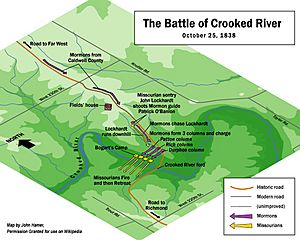Battle of Crooked River facts for kids
The Battle of Crooked River was a small fight between a group called Latter Day Saints (also known as Mormons) and a state army group from Missouri. This army group, called a militia, was led by Samuel Bogart. The battle happened near Elmira, Missouri, in Ray County. It was an important event in the 1838 Missouri Mormon War. After the battle, the governor of Missouri gave an order, sometimes called the "Extermination Order." This order made Mormons leave Missouri.
Contents
Why the Battle Happened
Growing Problems in Missouri
In 1838, problems grew between members of the Church of Jesus Christ of Latter Day Saints and their neighbors. These problems were happening in northwestern Missouri. Ray County was just south of Caldwell County, where many Mormons lived.
Between these two counties was an empty area. It was about 24 miles long and 6 miles wide. People called this area "Bunkham's Strip." Ray County managed this strip for government and army reasons.
Worries in Ray and Clay Counties
People in Ray County and Clay County started to worry about the Mormons. This happened after some people who disagreed with the church left Caldwell County. These people had been leaders in the Latter Day Saint church in Missouri. They moved to Richmond and Liberty. They said Mormons had threatened them and taken their things.
Fights in other areas made people in Ray and Clay counties worried. This worry became very strong when two Mormon leaders, Thomas B. Marsh and Orson Hyde, came to Richmond. They said a Mormon group called the Danites had attacked a town called Gallatin. They also said the Danites planned to burn Richmond and Liberty. This news made people very scared. Families moved across the Missouri River for safety. The state militia was put on alert. Later, it was found out that this alert was caused by someone who wanted to turn people against Mormons.
Leading Up to the Fight
Captain Bogart's Actions
General David Rice Atchison was the leader of the state militia in northwestern Missouri. He told Captain Samuel Bogart of Ray County to patrol Bunkham's Strip. Bogart's job was to "prevent any armed people from entering Ray county." A local resident said Captain Bogart and his men were not very careful. Bogart had been part of a group that bothered Mormons before.
Bogart and his men started visiting Mormon homes in Bunkham's Strip. They took away their weapons and told them to leave Ray County. Bogart even went into Caldwell County and bothered Mormons there. He told them to move to Far West, Missouri. When Bogart returned to Ray County, his men captured three Mormons. Their names were Nathan Pinkham, Jr., William Seely, and Addison Green.
Mormons Plan a Rescue
News quickly reached Far West that a "mob" had captured Mormons. People thought the mob planned to kill them. Around midnight, an armed group formed to rescue them. David W. Patten led this group of Caldwell county militia. Patten was known as "Captain Fear-not" because he was brave. The Mormon group quickly moved south on the main road to Richmond.
The Battle Begins
On the night of October 24, 1838, Captain Bogart's group camped by the Crooked River. Patten and the Mormon rescue group came from the north. They had traveled about 12 miles from Far West since midnight. At sunrise on October 25, the Mormons met the militia's guards. A short gunfight started. Each side said the other shot first. One of the guards, John Lockhart, shot Patrick O'Bannion, who was the Mormons' scout. O'Bannion later died from this injury. Lockhart and the other guards ran down the hill to the militia camp. The militia then got ready to defend themselves.
The Charge
The Mormon group came closer to the militia camp. They formed a battle line in three rows. David W. Patten, Charles C. Rich, and Patrick Durfee led these rows. Rich later said that the militia "fired upon us with all their guns." A general gunfight began. But the militia were behind the riverbank, which was a good spot for defense. Patten decided to charge the militia. He shouted the Mormon battle cry, "God and Liberty!" The Missourians did not have swords. They broke their lines and ran across the river in all directions.
During his charge, Patten was shot and badly hurt. He later died. Someone who was there remembered that Patten was "brave to a fault." Another Mormon, Gideon Carter, was also killed. In total, three Mormons died and one militiaman died. The Mormons gathered their wounded and the things Bogart's group left behind. Then they went back to Far West.
What Happened Next
Escalation of the War
The battle resulted in four deaths. It caused the Mormon War to get much worse. News about the Mormons' actions and the battle reached Missouri Governor Lilburn Boggs. The reports were exaggerated. Some said half of Bogart's men were lost. Governor Boggs believed the Mormons were openly rebelling. He ordered 2,500 state militiamen to stop them.
Two days later, Governor Boggs gave an order. It said that "the Mormons must be treated as enemies." It also said they "must be exterminated or driven from the state." He told the militia to make this happen.
Tragedy and Arrests
On October 30, a group of about 200 men killed 17 men and boys at Haun's Mill. The next day, Joseph Smith and about 50 other church leaders were arrested. Most of these leaders were let go within three weeks. In November, the rest were taken to different jails. Joseph and Hyrum Smith were accused of serious crimes. They escaped while being moved to another county.
In the end, most church members had to leave Missouri. They were forced out by the governor's order.


